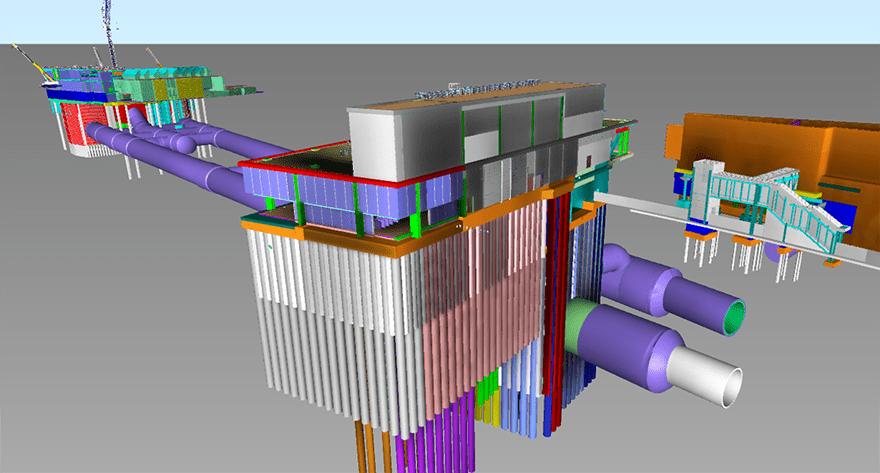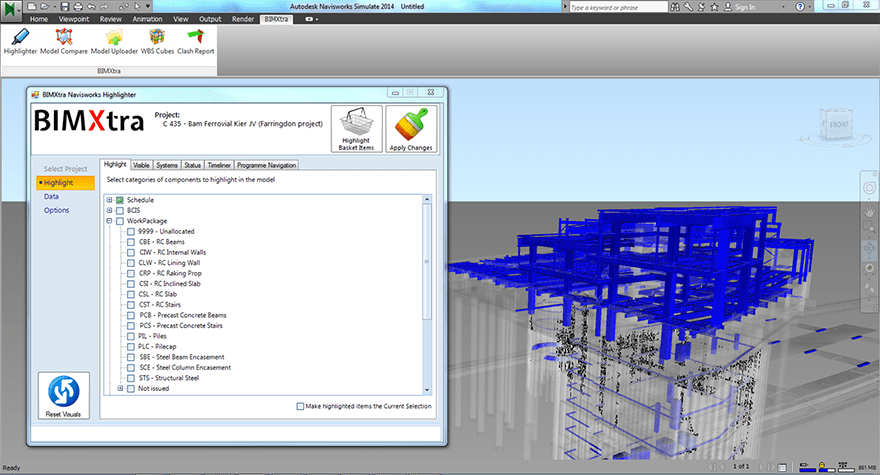- Client: Crossrail
- Lead Contractor: Team BFK, a joint venture between BAM, Ferrovial and Kier
- BIM Tools: Clearbox BIMXtra, Autodesk Navisworks, Oracle Primavera
The C435 Farringdon Station project involves building a new Eastern Ticket Hall next to Barbican Station, a Western Ticket Hall linking to the existing Farringdon Network Rail/London Underground station and the tunnelling and platforms connecting the two.
Team BFK’s contract covers the sprayed concrete lined tunnelling work, construction of shafts for the ticket halls and new station buildings up to Level +3. Along with this, BFK is responsible for the MEP and fit-out work on the station buildings, platform tunnels and ticket halls.
BIM was considered vital due to the project’s vast scale, and the need to coordinate work on the constrained site in congested central London.
In addition to geometric 3D models, the team developed models incorporating accurate laser scans of the existing station, nearby buildings and roads to help visualise the logistics of the site, coordinate road closures and crane movements and carry out design coordination.
Linking the federated 3D model to the programme of work to produce 4D sequencing was streamlined through the use of BIMXtra, originally developed by a Kier Group company, with Oracle’s Primavera P6 (version 8.2) project management software.

BIM was considered vital due to the project’s scale, and the need to coordinate work on the constrained site in a congested area
“Projects typically link the programme to the 3D model using much less sophisticated software, making it a long-winded process to incorporate future programme changes,” says James Martin, head of technical services at Team BFK. “Permanent links were added into P6 that made it possible to automatically update the BIMXtra 3D model in response to any changes to the programme of work. It only takes a couple of clicks of the mouse to update.”
The BIMXtra 4D model is available to all appropriate project stakeholders via the cloud to view and interrogate the construction sequence from any point in time, without the need for third party software.
“Using 4D has help us bring the programme to life, enabling all project stakeholders to review how and when we would complete different aspects of work, such as demolishing areas of the existing ticket hall and relocating hoardings to protect commuters using the station through the duration of the job,” says Peter Austin ICIOB, BIM manager for Kier Infrastructure.
The use of BIMXtra enabled further project efficiencies by reducing the amount of data held within the federated 3D BIM model. A typical 3D BIM model can feature a large amount of design schedule data related to components, such as colour, fire rating and other attribute information, creating a large data file that can take a long time to download, or cause lag.

Linking the federated 3D model to the programme of work to produce 4D sequencing was streamlined through the use of BIMXtra
At Farringdon, the 3D BIM models are data-light, incorporating only geometric, part/family and dimensional information. When the user clicks on a component they are automatically directed through to the design schedules, where the asset data is held.
“Downloading granular pieces of information like this, as and when you need them, is a much more efficient and less unwieldy process,” says Austin. “Links can also be added to include information on design status, the person with responsibility for the work and the subcontractor delivering the package etc. The way it is structured enables us to better manage the project as well as the design.”
Team BFK is now looking at how similar automated links in BIMXtra can be used to automatically output asset information for use by the client post-handover, although Crossrail has yet to specify how asset data should be handed over. It is thought automating this process could save thousands of man hours manually updating excel spreadsheets with asset data.
The software innovations detailed here have helped Team BFK deliver Level 2 BIM at Farringdon to a higher degree of success than other contractors claiming to meet the standard, says Austin: “There are lots of companies demonstrating Level 2 BIM without necessarily having a robust process of importing the 3D models and linking them to the programme and costs to create an effective project management tool. That’s what BIM should be about and what we are implementing here,” he concludes.
Using 4D has help us bring the programme to life, enabling all project stakeholders to review how and when we would complete different aspects of work, such as demolishing areas of the existing ticket hall and relocating hoardings to protect commuters using the station through the duration of the job.– Peter Austin ICIOB, BIM manager, Kier Infrastructure











